Wink Commander Postmortem Part 2: Post-jam Development
This post is Part 2 in a 3 part series. Part 1 looks at the game's inspirations and gives a day-by-day jam log. Part 2 explores the intention behind post-jam updates and cut features. Part 3 dives into the music contributed by various talented musicians.
Contents
This post is very long! Feel free to skim/jump to the bits you're interested in.
- Initial tweaks
- Post-jam work
- General reflections
- What went right
- What didn't go so right
- What got left out
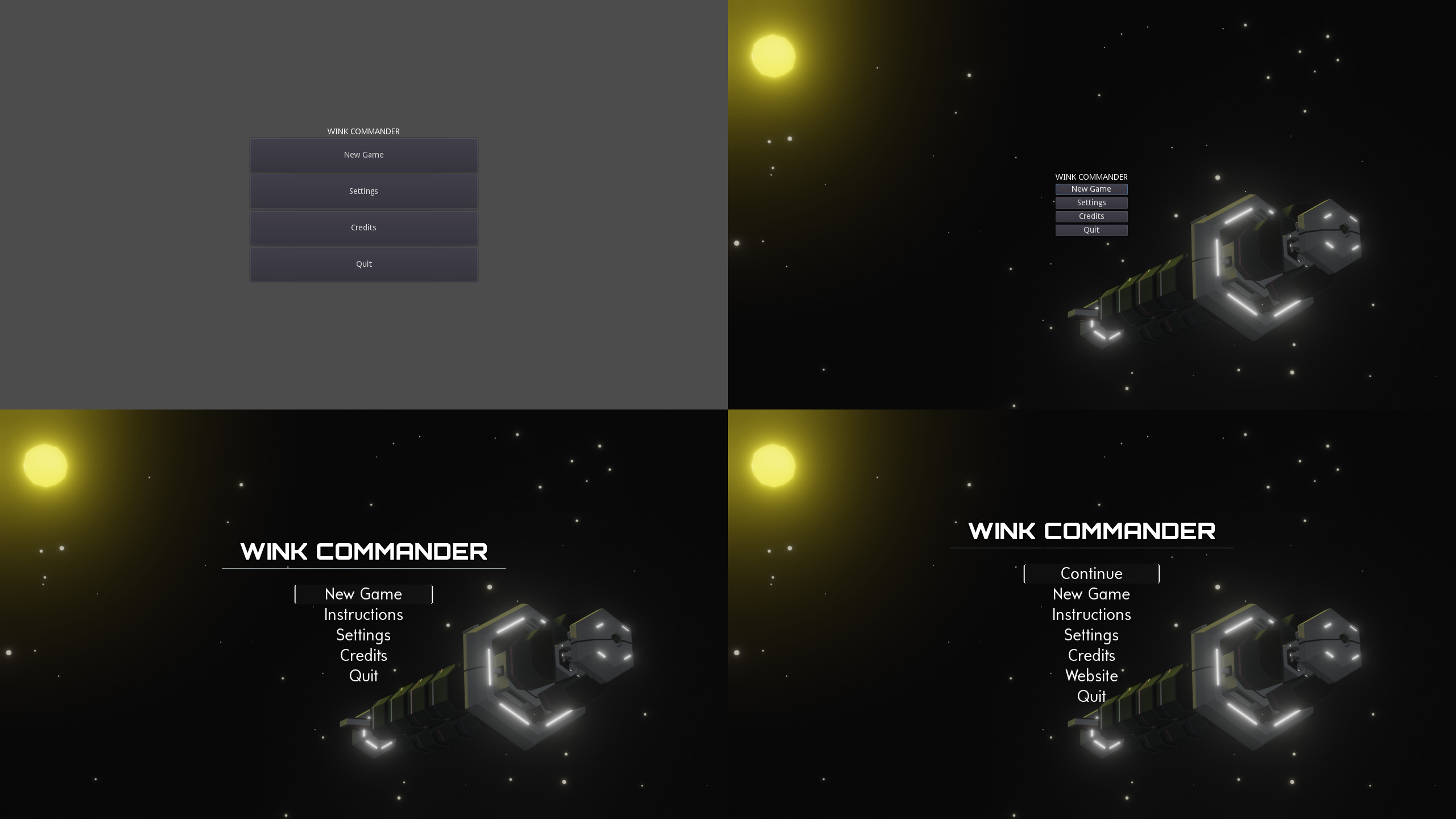
Initial tweaks
In the couple of days following submitting Wink Commander, I made a thread celebrating all the contributing musicians, and shipped a post-jam patch with a few miscellaneous tweaks and fixes.
In order to make the early game a little more interesting and help emphasise as sense of discovery while learning its mechanics, I updated the map to only display routes that have been or are being travelled by the player. This keeps the amount of choice and information low earlier in the game and gives more to think about as the player becomes more familiar with what's going on.
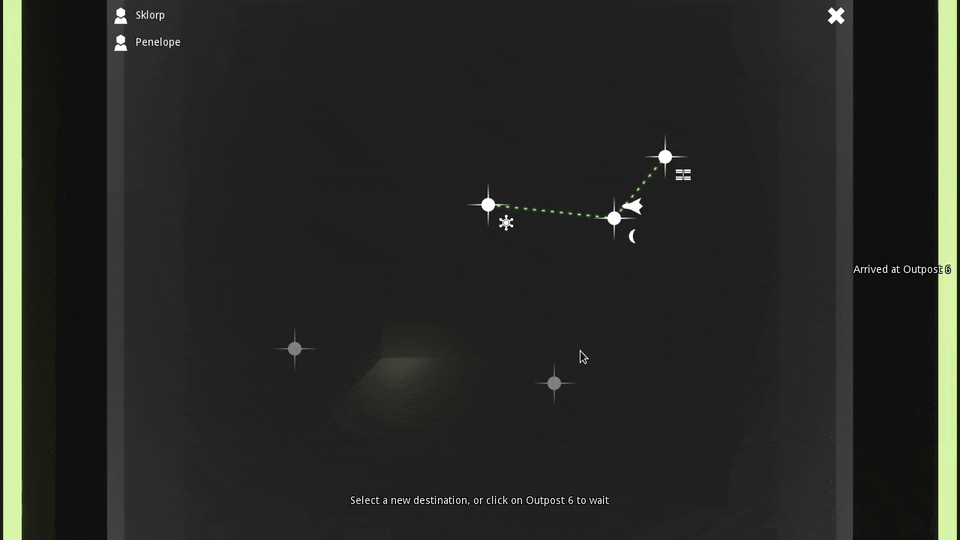
I added an animation to ship icon, making it repeatedly move along the selected route to give a clearer sense of direction. I updated the comms station light to flash in order to be more eye catching in the mirror, and I discovered my oversight with my collision handling code and made it so that the player can "slide" along colliders when bumping into stuff.
When writing the patch notes, I presented them as an in-fiction message from a fictional "Space Corp," framing map changes as upgrades to the comms station's software, collision improvements as addressing manufacturing flaws in floor plating, and hidden-until-discovered routes as the result of a systems wipe following a triple-disaster of space worms, mind worms, and computer worms. It felt nice to be able to give a hint at what kind of tone/flavour any narrative elements might have had if I'd gotten to them.
Post-jam work
It's always difficult to know for sure how things will be received until they are received, but in all of the post-jam work I did on Wink Commander, my priority was doing things that would elevate, surface, or polish stuff I had attempted during the jam rather than to grow it into anything beyond what I had set out to achieve.
Up until the first of January, I continued to work on a larger post-jam update where my main goals were to help expose aspects around building relationships with/context for pilots, and to add a little more interactivity outside the chair to help make the ship feel like a space that the player lives in.
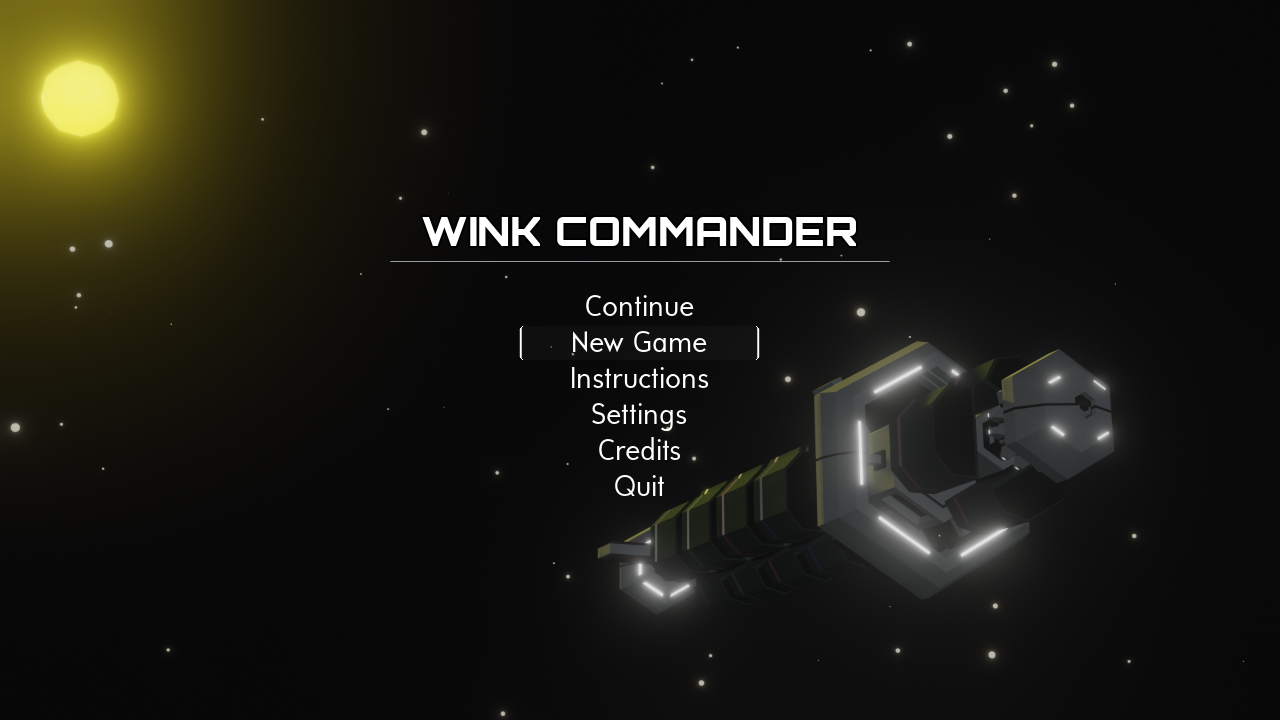
Going back to those first impressions I was talking about in Part 1, giving some attention to the main menu and so forth was something I did early on. I made a theme that was flat, minimal, and hopefully felt a little sci-fi-ish. I picked an black (very bold) variant of an old favourite Orbitron for headings (its square glyphs evoke a particular ideal of futuristic computer stuff) and Universalis ADF for body text (a sans serif font that is understated, but carries some hints of sensibilities seen in art deco typefaces). To me, both of these choices evoke slightly different flavours of retrofuturism. Universalis' humanist proportions would feel at home on the radio model if it was high fidelity enough to warrant text, and all-caps Orbitron Black's thick, straight lines boldly imply advanced computer-driven technology. I had intended to also use an old IBM font for electronic messages in the game, but only ended up using it to make some 3D geometry to flash as autopilot notices on the console.
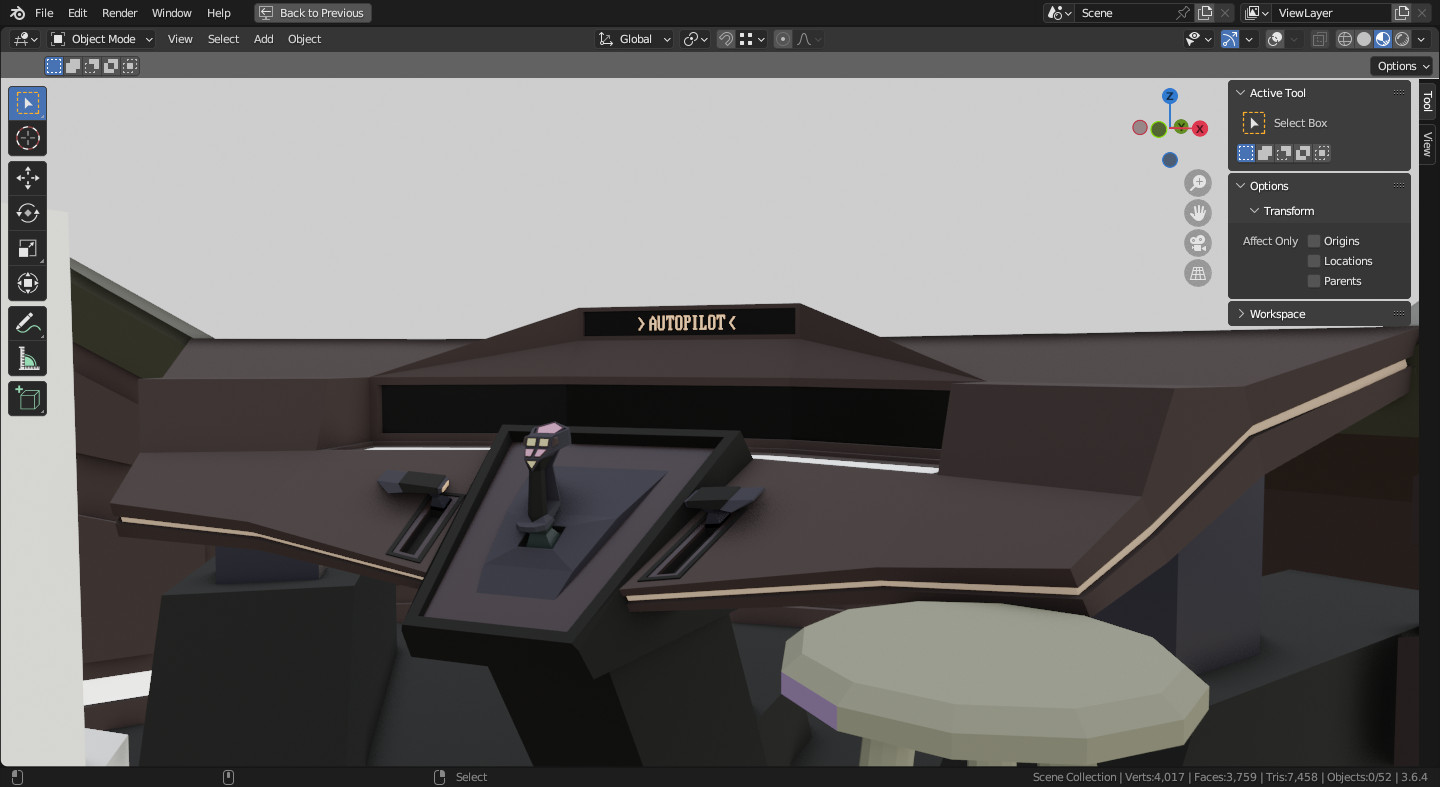
I brought in a library called Fontinator I made many years ago that handles loading fonts into pre-existing DynamicFont resources at runtime, and manages updating their sizes to be appropriate for whatever the current window size happens to be.
From the beginning, I'd wanted to do a selection interface for choosing hand gestures. With only two gestures, it made sense to just permanently bind thumbs up to the left arm and salute to the right. I made several more gesture animations (thumbs down and wave, and left/right halves for clap and shrug), and implemented a radial menu using a combination of what I did in Hive Time and what I was planning to use for Fossil Sweeper's museum interactions. All gestures can now be bound to either arm, giving more flexibility and increasing the possibility space of interactions to an extent that requires the player to think and react when presented with an NPC pilot.
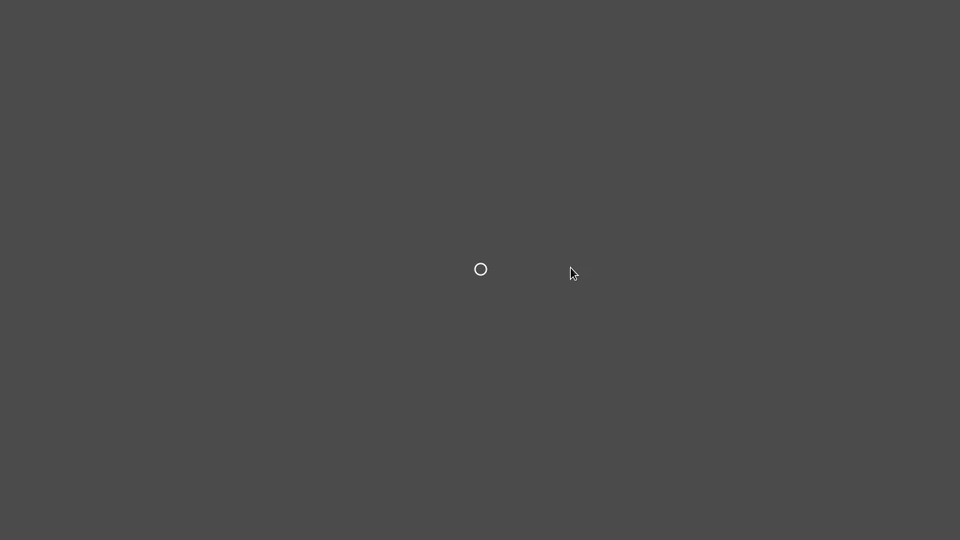
Another thing I had on my wishlist from the start of the project was a "messages" screen where the player could receive messages from (and potentially send to) NPC pilots as a way of reinforcing the growing social context being built through passing gesture interaction, as well as a place to surface NPC characterisation and NPC-specific "quests" that would unlock at higher disposition levels.
I didn't end up with time to write per-character messages, but I was able to write a bunch of placeholder messages for communicating when disposition thresholds were crossed. The messages screen filters messages by sender, and also felt like a good place to show extra information on the NPC pilots - interaction counts, disposition, likes, dislikes (I'll come back to those in a bit), and a portrait to hopefully allow them to be more memorable. Once the first disposition threshold is crossed, the portrait shows their preferred gesture, giving a reference for future interactions if needed.
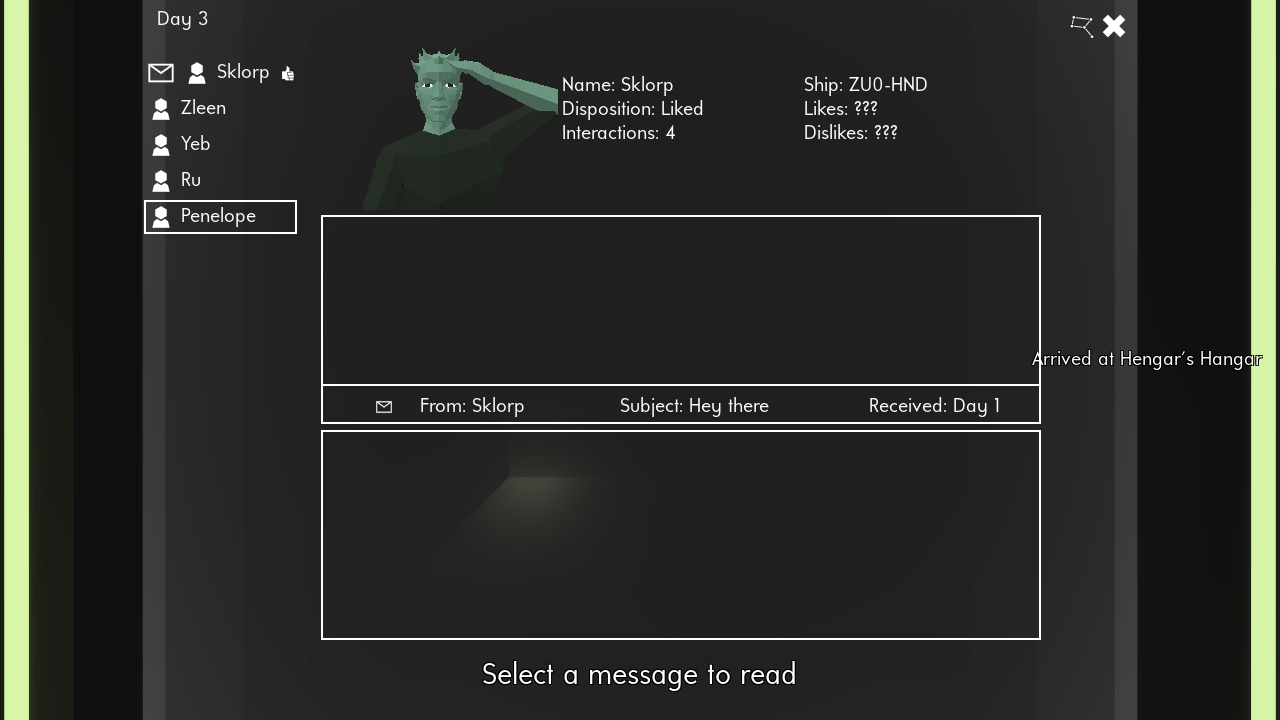
The messages screen is presented as another mode for the comms station, accessible by clicking on an NPC pilot's name, which has an envelope icon when an unread message is waiting.
Speaking of the map screen, I added a separate NPC ship indicator for each pilot (instead of only having one and moving it around to show the current NPC pilot's position) so that I could show indicators for all known pilots leaving a location when hovering over it. The new NPC pilot indicators are animated to better communicate their direction of travel.
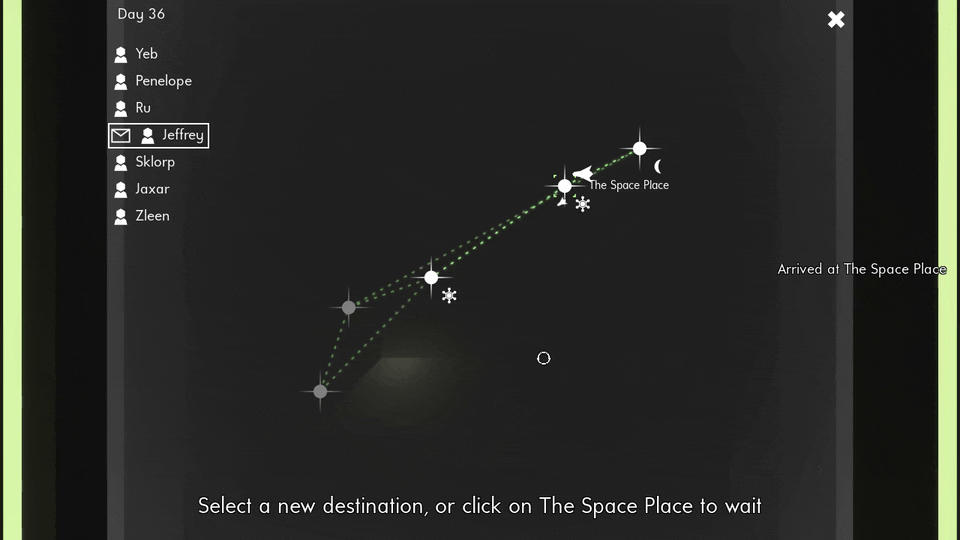
Since messages have a date field (measured in "days," which increment when travelling or waiting, effectively making it a turn counter), I felt that putting the current day on the map would help make it easier to have awareness of time, both for getting context for messages, and for more consciousness about playtime and how long it takes to cultivate a relationship with an NPC pilot.
I did a sound recording session and taking samples of various things around my house, trying to get stuff that could work for ambient ship sounds and particular interactions, including various my washing machine while washing some bedding, running taps, a cistern refilling, windows opening and closing, computer fans, CD and DVD player drawers opening and closing, blinds opening and closing, doors opening and closing, etc.. I also recorded some typing sounds on a keyboard with the intent of having that idly play while viewing the map screen, but I ran out of time to implement that.
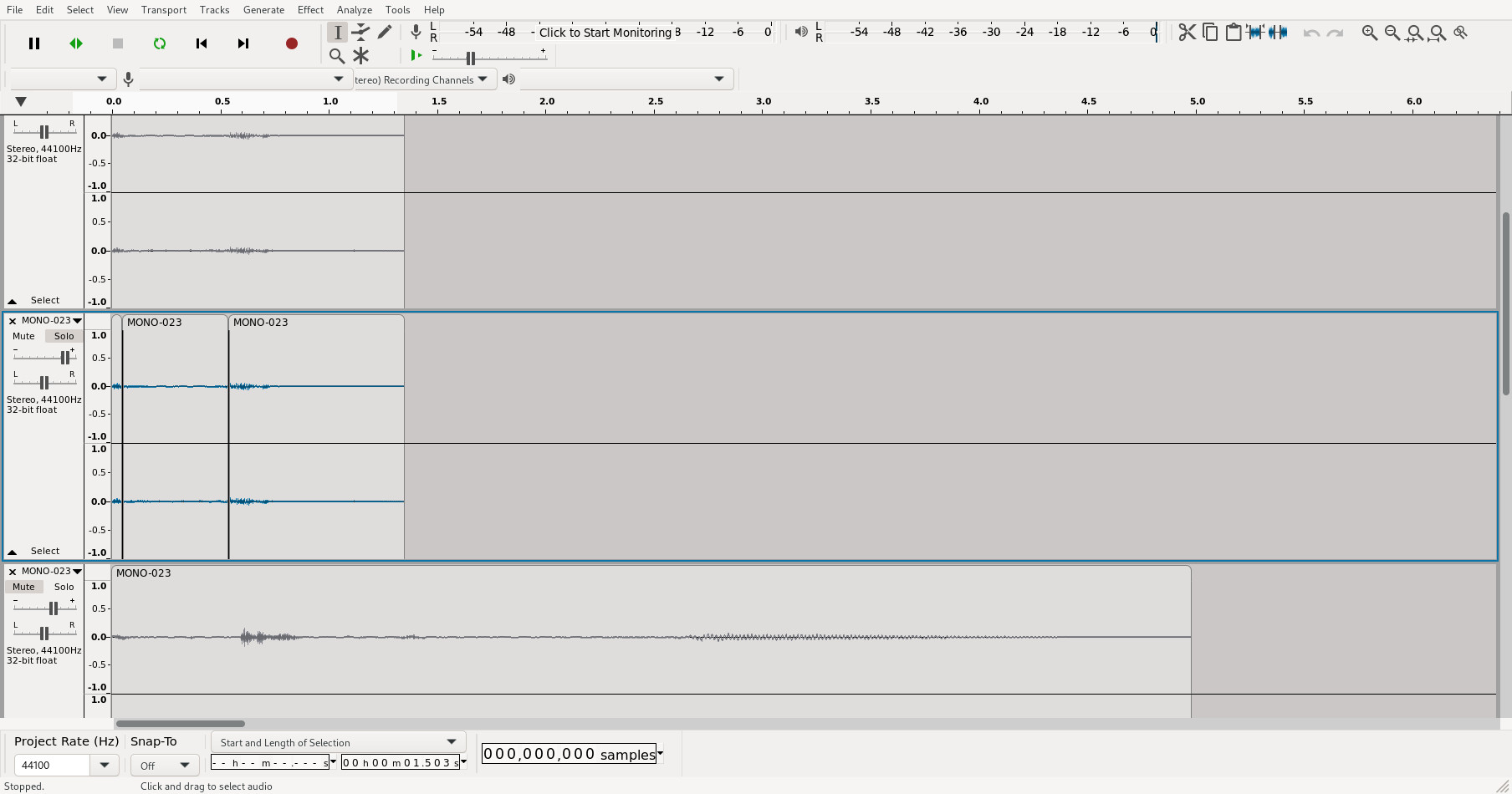
For ship ambience, I ended up using a sound that Drew had put together, and changed its pitch and volume depending on the ship's current state.
For proximity alert sounds when an NPC pilot is approaching or departing, I used the same approach I'd used far FLAT's UI sounds, using Tenacity's built-in DTMF tone generator, speeding them up, overlapping them, and then throwing some reverb and reversed reverb over the top. The results are surprisingly soft/pleasant when compared to the source DTMF tones, and to me, does a great job of communicating "futuristic computer" for the effort it takes to make them.
I also wanted to make the game playable by the blind/vision impaired players of some of my other games, and added TTS support for various menus, UI elements, and gameplay events. I didn't quite get it solid enough that I feel comfortable advertising the game as blind-friendly - there are still a few important things that don't have audio cues like NPC pilots responding to gestures, or moving the cursor over an interactable object. Hopefully I'll be able to return and tidy that up in the future.
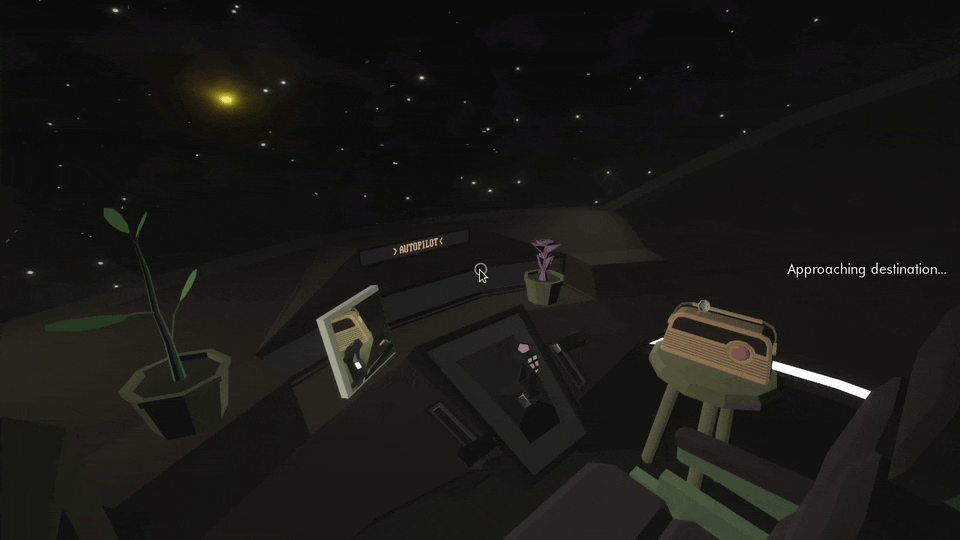
I'd always envisioned the console as being covered in flashing lights and dials and buttons. I was hoping to really flesh out that detail in these post-jam updates, but other stuff always felt higher priority. In the end, aside from the autopilot indicator, I only ended up adding a joystick and throttle controls on the left and right of it. Neither are interactive, but the throttle does animate when the ship is arriving at or departing from a location in time with the star particles and engine sounds changing.
My plan for those console buttons was that they'd do unexpected things unrelated to operating the ship (eg: push an important looking button, and a little door slides open and give you a doughnut). In addition to being amusing, I hoped this would suggest that the cockpit had been tailored to be more functional as a living space for the player. Back when I'd started blocking out the revised cockpit design, I'd also modelled a water cooler and some drawers that for a long time were sitting just outside the wall behind the comms station.
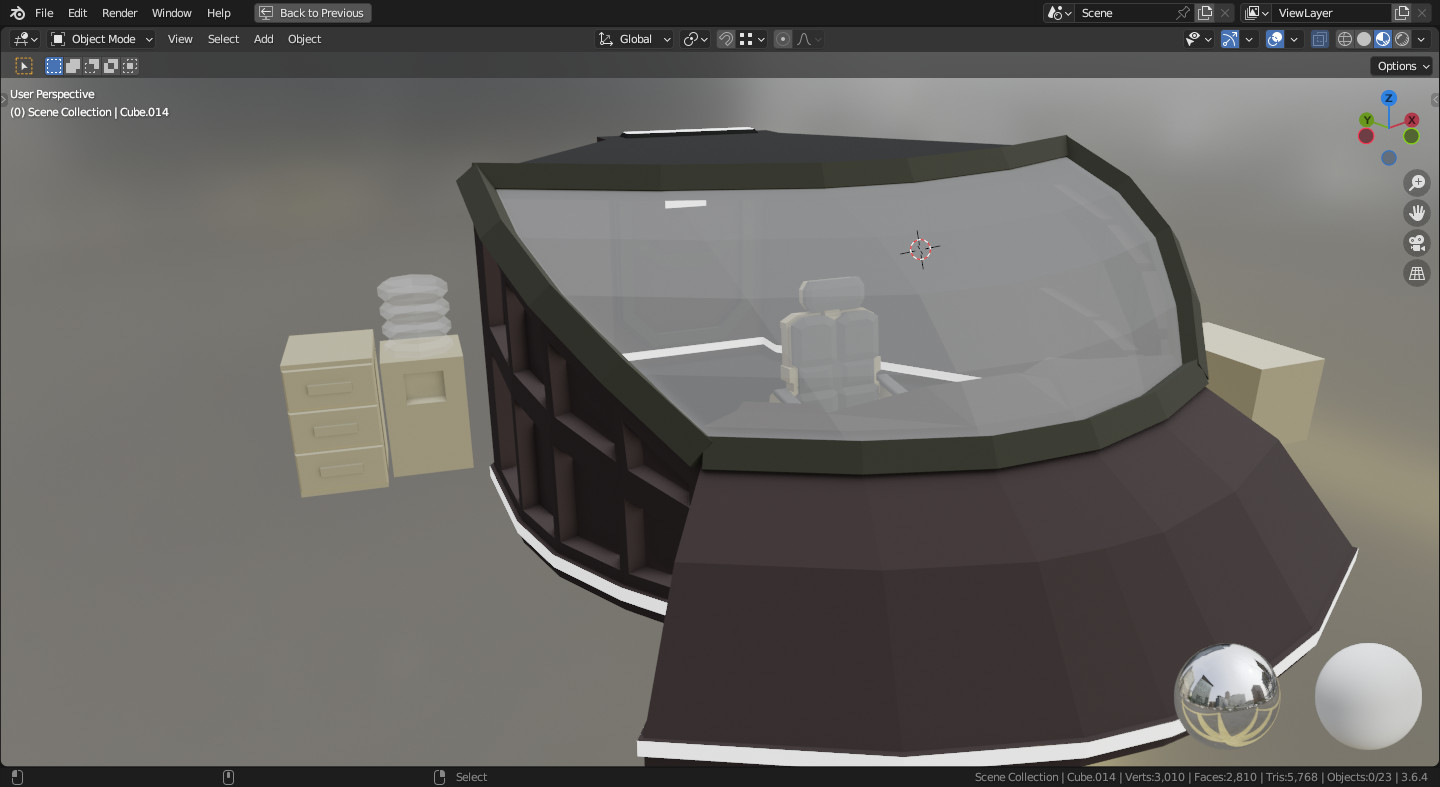
I did decide to bring some of that back though, by adding interactive "props" that the player can pick up and place around the ship. I'd made ten or so low poly prop models during a Blendsday session, including potted plants, some foodstuffs, and a stuffed bee toy. Initially I was planning to make the bee an easter egg that would only be present in the game if a config file for Hive Time could be found, but in the end, I decided it'd be better to just have a wider range of props in the game. For placement, I allow props to be put down if the player is looking at any horizontal collider surface (which the floor doesn't have), and added some colliders to the flat spaces on the front console.
In order to focus on other things, I put aside prop interactions like watering plants or consuming food, but I did update expression processing to treat each held props as its own gesture. I gave pilots a randomly assigned set of likes and dislikes that give bigger disposition boosts. Discovered likes and dislikes get added to lists the pilot summary on the messages screen. My hope is that this allows pilot interactions to feel a little deeper, and gives players something to work out/pursue once they've explored the entire map and gathered a good number of contacts.
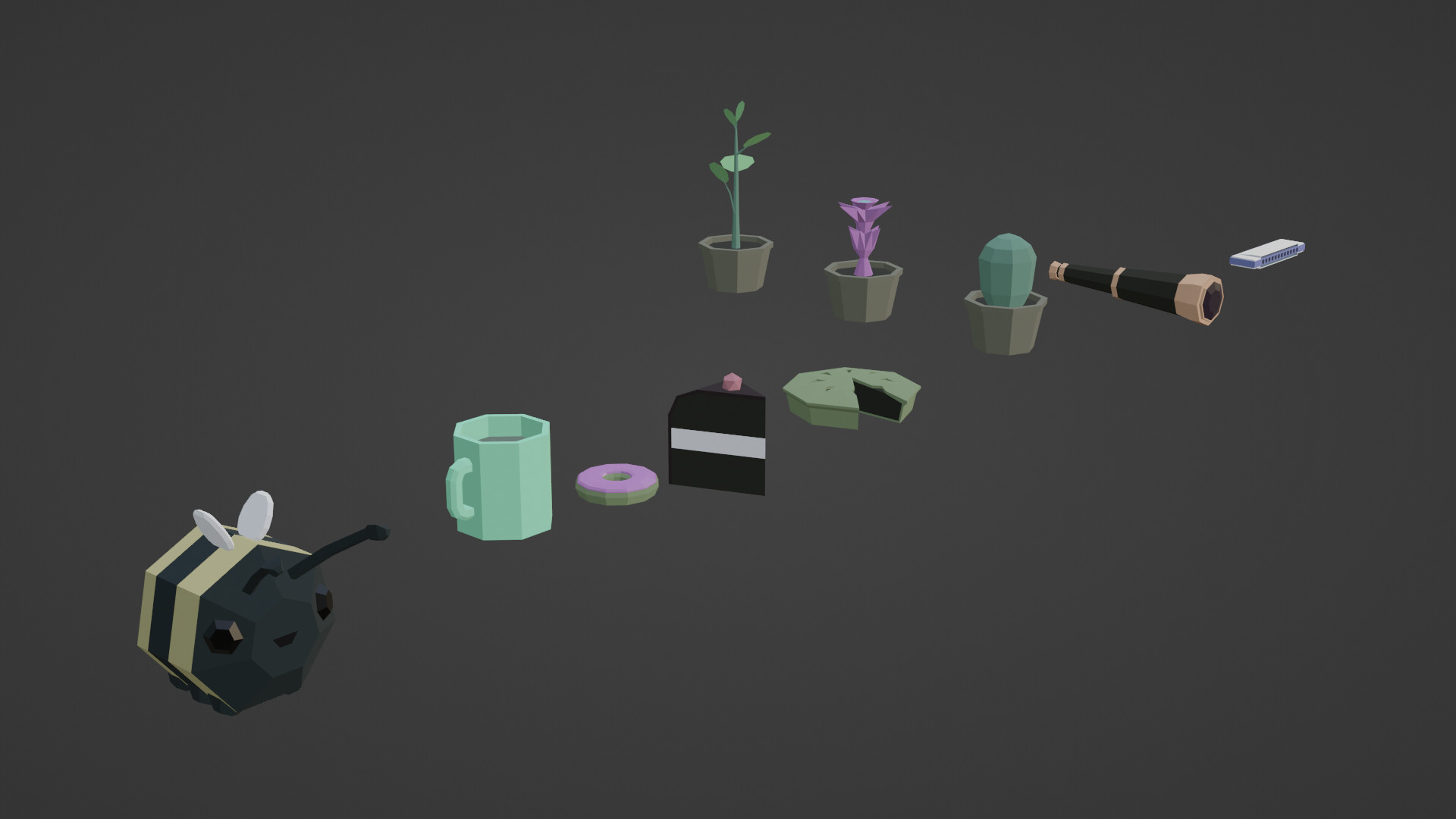
Three random props spawn at the start of the game in various locations around the ship, hopefully making initial exploration a little more interesting, and leading players to pick stuff up and organically discover how that affects gestures. To allow more room for that, I extended the window for interacting, and allowed multiple interactions to occur is the first disposition threshold has been crossed. It's still not the more complex combination based stuff I had originally wanted to pursue, but I think that along with additional gestures/expressions, and reaction animations, it's a good improvement.
When NPC pilot's disposition is maxed out, they'll leave a new prop for the player to pick up at the NPC pilot's current location. Initially I had these spawning on the front console as a not-great-but-good-enough solution, but it was easy to miss, so I added a little recess into the blank wall behind the placeholder console, opposite the comms station, which has some lights and sounds when a prop is arrives. It's not visible from in the chair, but the lights are on, it's pretty hard to miss when wandering around the cockpit.
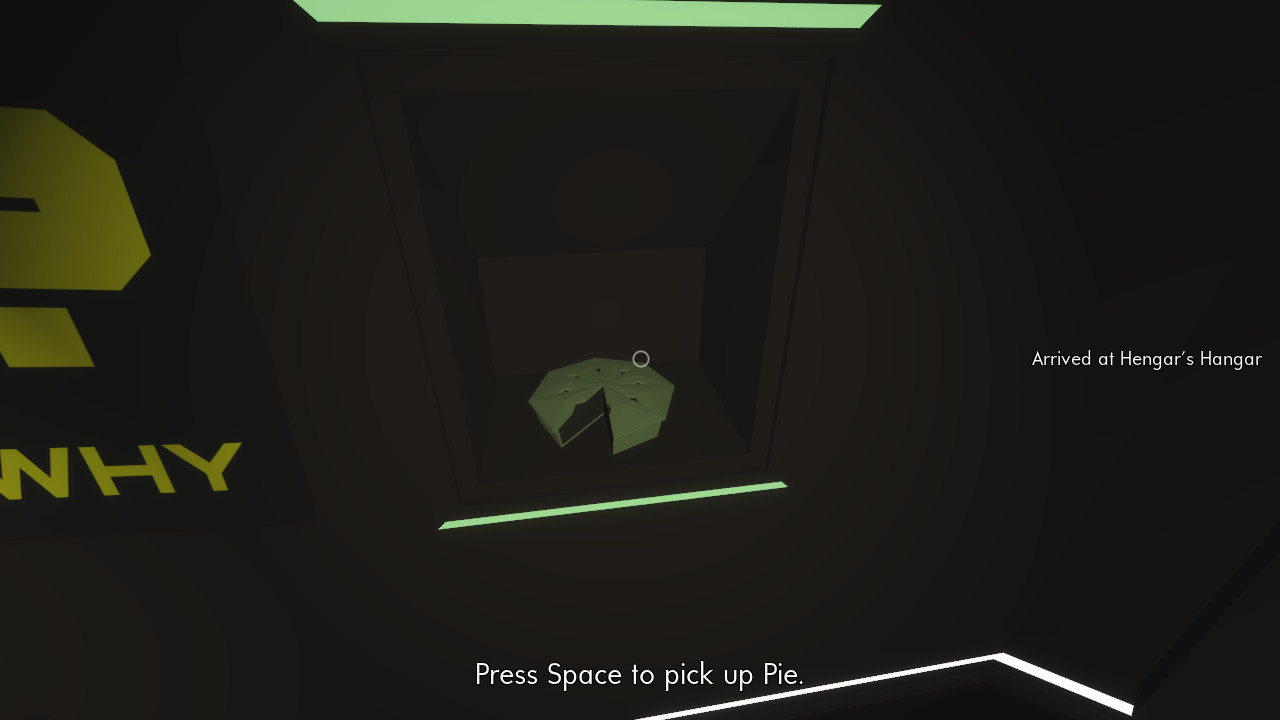
When all props have been acquired, an "end game event" occurs, where a new unknown contact sends a message, alluding to an in-fiction event that would dramatically impact on the lives of the people, giving a hint at where I might have taken things if I had had time to focus on more narrative aspects. There's an out-of-fiction post-script with a thanks message from me to explicitly communicate that the player's seen everything there is to see.
I also hooked up Binder to allow all control bindings to be customiseable, and added auto saving when arriving at or departing a destination, as well as on quit, so that progress toward that "end game" can be preserved.
After props went in, the next most valuable thing was character variation, primarily to help make it easier to identify NPC pilots, but I was also keen to get double mileage out of it by allowing players to customise their character as well.
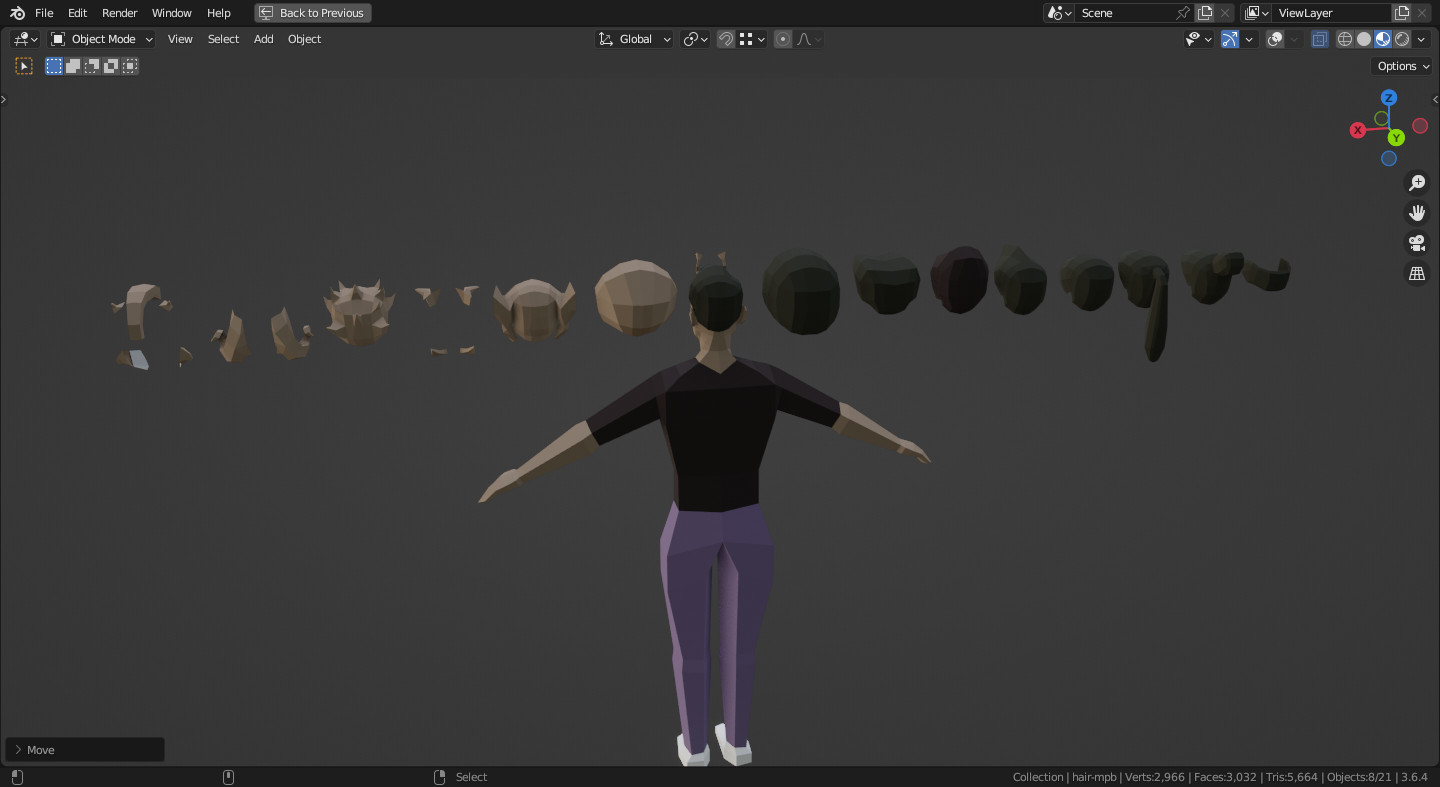
I modelled a bunch of additional meshes to fit onto the existing character model head. It was fun to think about how this mirrored some of the approaches to alien design in shows like Star Trek, where I could only add to the head volume and only do so in places where it wouldn't hurt readability of the existing expression shape keys. I made ridges, horns, bulges, ears, and so forth that I hoped would make it clear that there's more than just humans in this game. I made some hair meshes as well, originally intending to keep those separate from the head variants, but allowing them to double up ended up making more sense.
I also added a per-character UV offset, implementing the palette variation I was aiming for back when I first put the swatch texture together. I was hoping to make use of the resource_local_to_scene property to allow each NPC to have their own UV offset without needing to duplicate the material entirely, but that doesn't seem to work with the way I was instantiating things.
I had this idea that it would be fun to expose character customisation as something that happens in front of a sink and mirror, so I added a head (boat terminology for toilet, or the room containing a toilet) and a little adjoining room between that and the cockpit. Interacting with the mirror in there initiates a customisation flow that starts by getting the player to hold a gesture button to set their "dominant" hand (the one that will hold props and the side that the throttle animation will play on), then guides the player through selecting head, hair, and complexion.
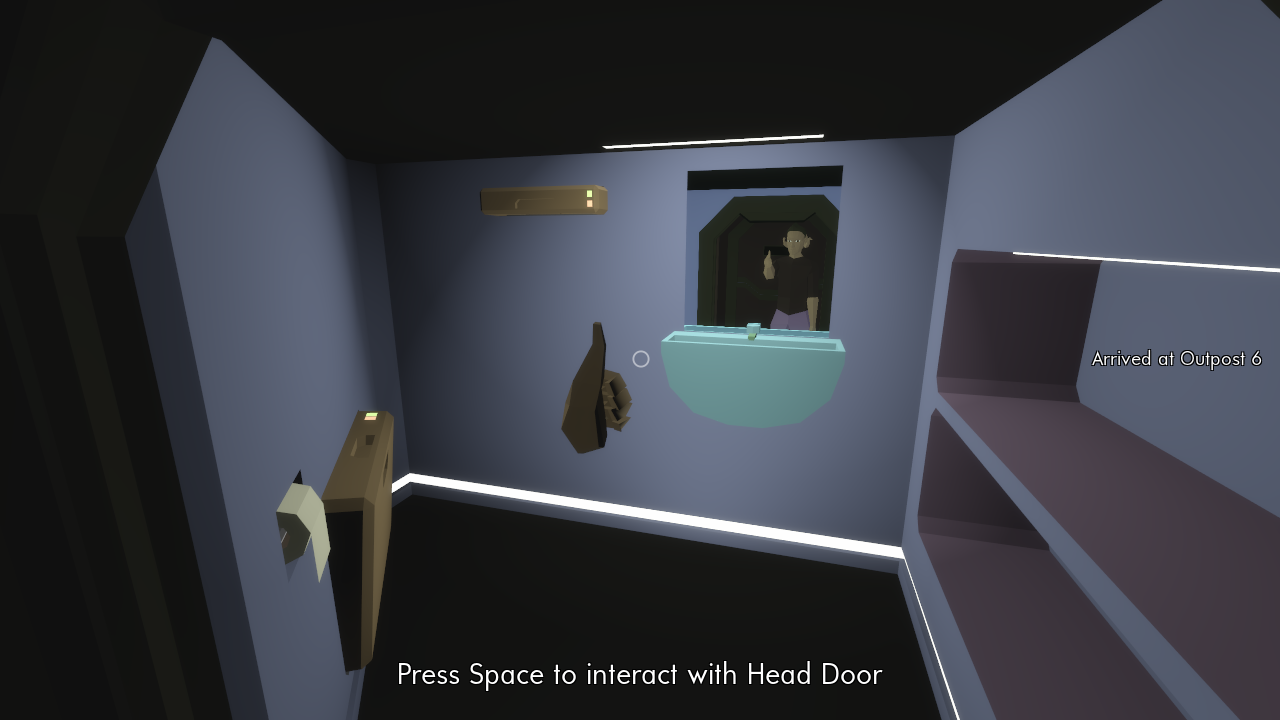
To flesh out the head, I added a space toilet set into the wall that looks like it could swing out to reveal a poopchute or whatever (I had wanted to make this interactable and animate it coming out from the wall, but I dropped that to save time), and a shower device with similar design. I also popped some shelves into the wall next to the mirror and added prop placement colliders, so players can have somewhere to put their doughnuts and pies when they need to do their business.
With an extra room, the HUD with NPC details being visible everywhere became a lot more obvious. I could have hidden it when the player isn't seated, but I think that knowing who's out there can help a player decide if they want to engage with an NPC, so showing that information before the player sits down is important. I added an extra camera with its own Viewport and world containing no lights that follows the main camera's position that can see second "windshield" mesh that has an emissive texture on it. I use the render texture from that as a mask for the HUD. This allows it to be obscured by the chair and doors, which was what I was after, and also the front console, which I wasn't expecting to be a problem. Rather than spending time doing some smart positioning of NPC HUD elements, I just made by ships spawn higher to make it less of an issue.
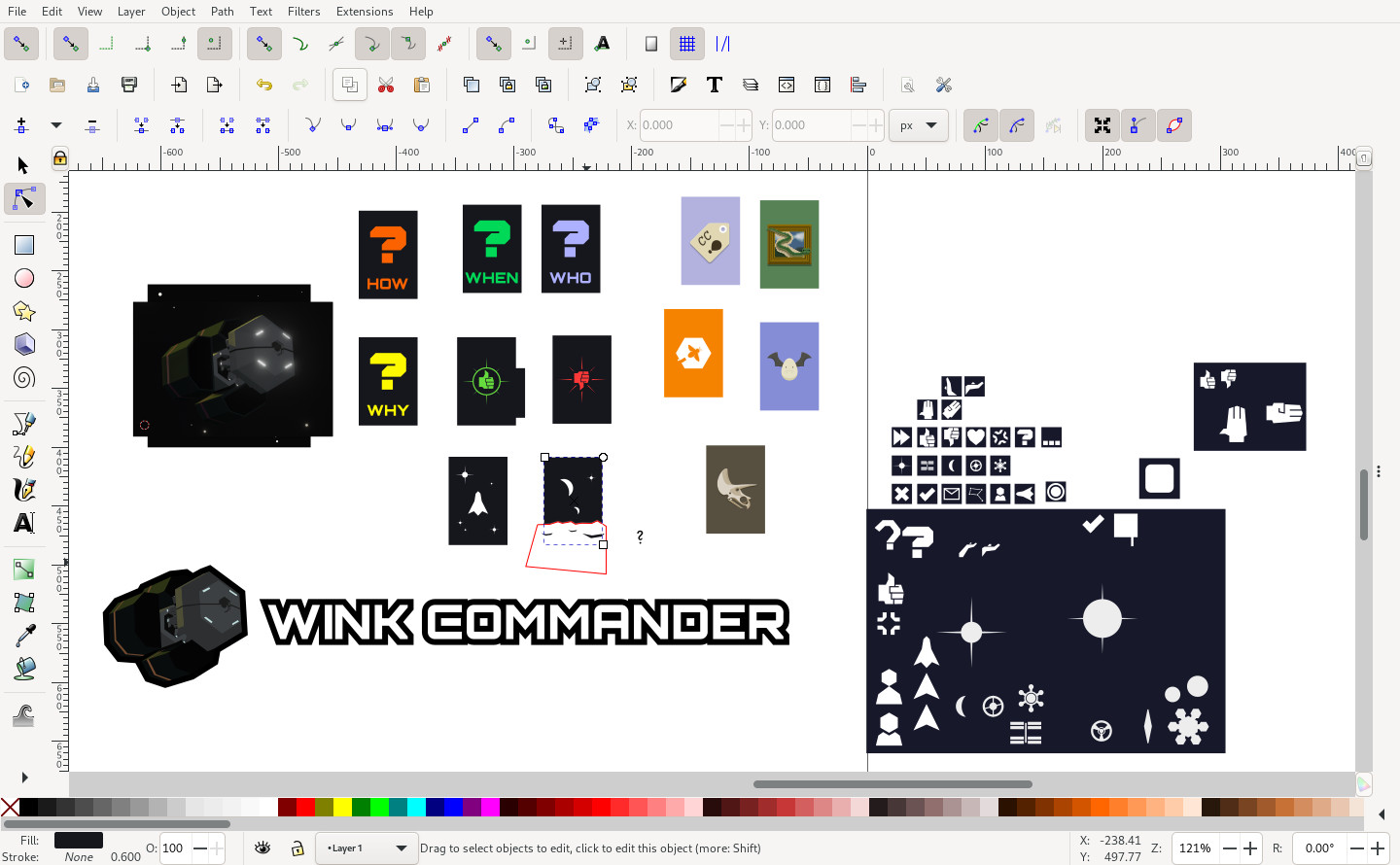
In response to some late feedback about the "stand up" collider being difficult to discover at the beginning of the game, I added a poster on the wall, positioned so that looking toward it would look directly at the chair collider. Early on, I had considered allowing the player to decorate the cockpit with posters and stickers, and even though these aren't interactable at all, it was nice to bring that idea back in some form. I quickly knocked together some poster designs, one based on an early icon concept featuring a thumbs up, two re-using icons I'd made for the map screen to suggest some space scenes, and one with a large question mark above the word "why."
I popped a couple of Empties into the cockpit (one poster felt like too few) in Blender and during new game setup, place quads with random poster textures at those locations. This worked well, so I added a few more question mark posters (I almost wish I hadn't because they're less interesting and feel a bit too paranoid when random selection makes all the posters be question marks).
The posters also felt like a nice way to implement the easter eggs for my other games, so I added special posters for Hive Time, Bat Egg, Cloud Courier, Fossil Sweeper, and ART for Snakes, with one randomly being picked to appear in the head if Wink Commander can find a user folder for that game.
General reflections
I managed to wrap up all that work in a couple of weeks or so, just barely missing out on shipping it before the end of 2024, and rolling out v0.3 on the 1st of January 2025. All up, I feel good about the post-jam changes I'd made. I definitely went beyond what was achievable within the 7DFPS' target time constraints, but I think I managed to avoid going beyond the kinds of things I had wanted to achieve during the jam, focusing on depending what was there rather than expanding the game's scope significantly.
The extra features and improvements in my post-jam work shifted a lot of polish balance, as is always the case. As some elements are improved the bar is raised, and rough edges elsewhere that didn't previously stand out end up feeling more visible. Sometimes that's more literal like adding a second mirror revealing that there's no walk animation, and other times that's stuff like being able to pick up props suddenly making it feel a bit weird that you can't pick up the radio or console mirror.
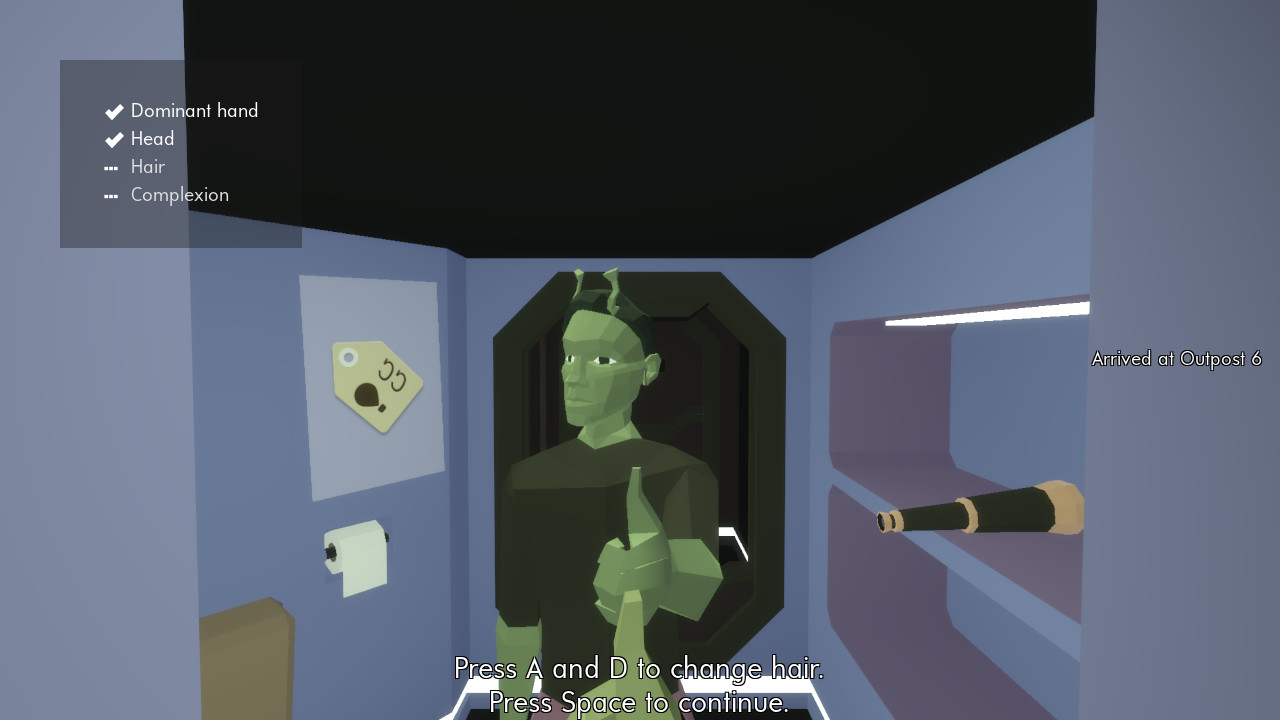
A lot of the polish items seen in the v0.3 patch were driven by that kind of thing, making me prioritise things I was previously happy to overlook, such as clipping the HUD to the front "windscreen," adding some more front console detailing, most menu improvements, or most of the new sound effects. The game as a whole benefits from these, which is great, but polish also informs expectations, which is important to be mindful of. Broadly, I think I managed to maintain a good balance with this post-jam work, even if I did do a few things that I wasn't initially intending, such as NPC messages and disposition rewards.
That aside, I still found room for a couple of small silly indulgences, such as renaming the "fastforward" binding to "daydream," reaming the "run" binding to "move_faster" and adding a "no running on the spaceship! >:C" tooltip, and to be honest, most of the props. These sorts of things make me happy while I'm working, and some of them help to reinforce the not-so-serious vibe of the game. It's the same kind of thing that led to the Beetles event in Hive Time and 90% of the stuff I did in ART for Snakes.
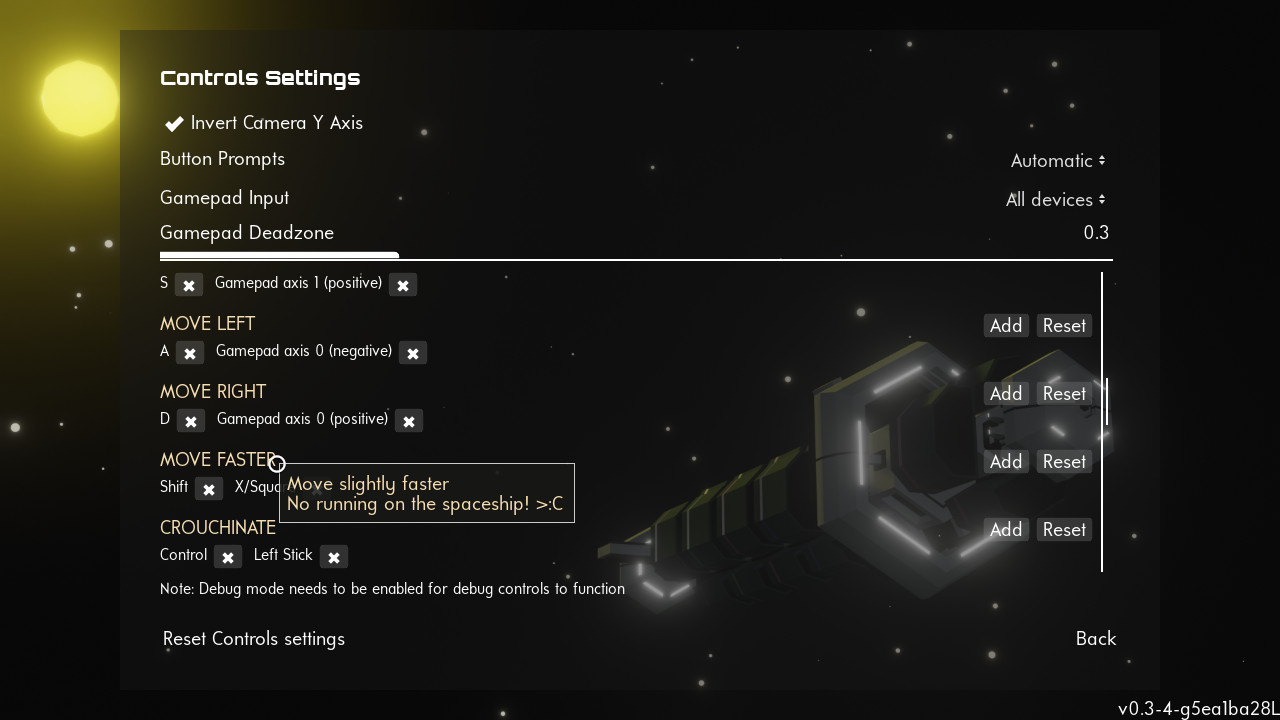
I can still imagine and would love to play a larger version of this game that explores the narrative aspects that I didn't get to (more on that below), but I think that's something to weigh up against the other projects on my todo list after Fossil Sweeper ships.
If I ever come back to Wink Commander, I think I'd need to change the name. It's a fun/funny joke, but the game itself doesn't really draw from, refer to, or offer commentary on Wing Commander, so the implied association feels gratuitous and misleading.
What went right
The biggest "success story" from Wink Commander has been the music. From a technical perspective, I made a system that could scale up or down and function the same regardless of how many tracks were in the game, and so far as the feedback I've received so far goes, I think I gave my collaborators a positive experience. I do wish that I had more time to be "present" and supportive/involved, but I think the results are outstanding regardless. I love the range and diversity of music in the game, and what that implies for its setting, and I'm thankful to have had an opportunity to work with a bunch of cool artists (more on them in Part 3).
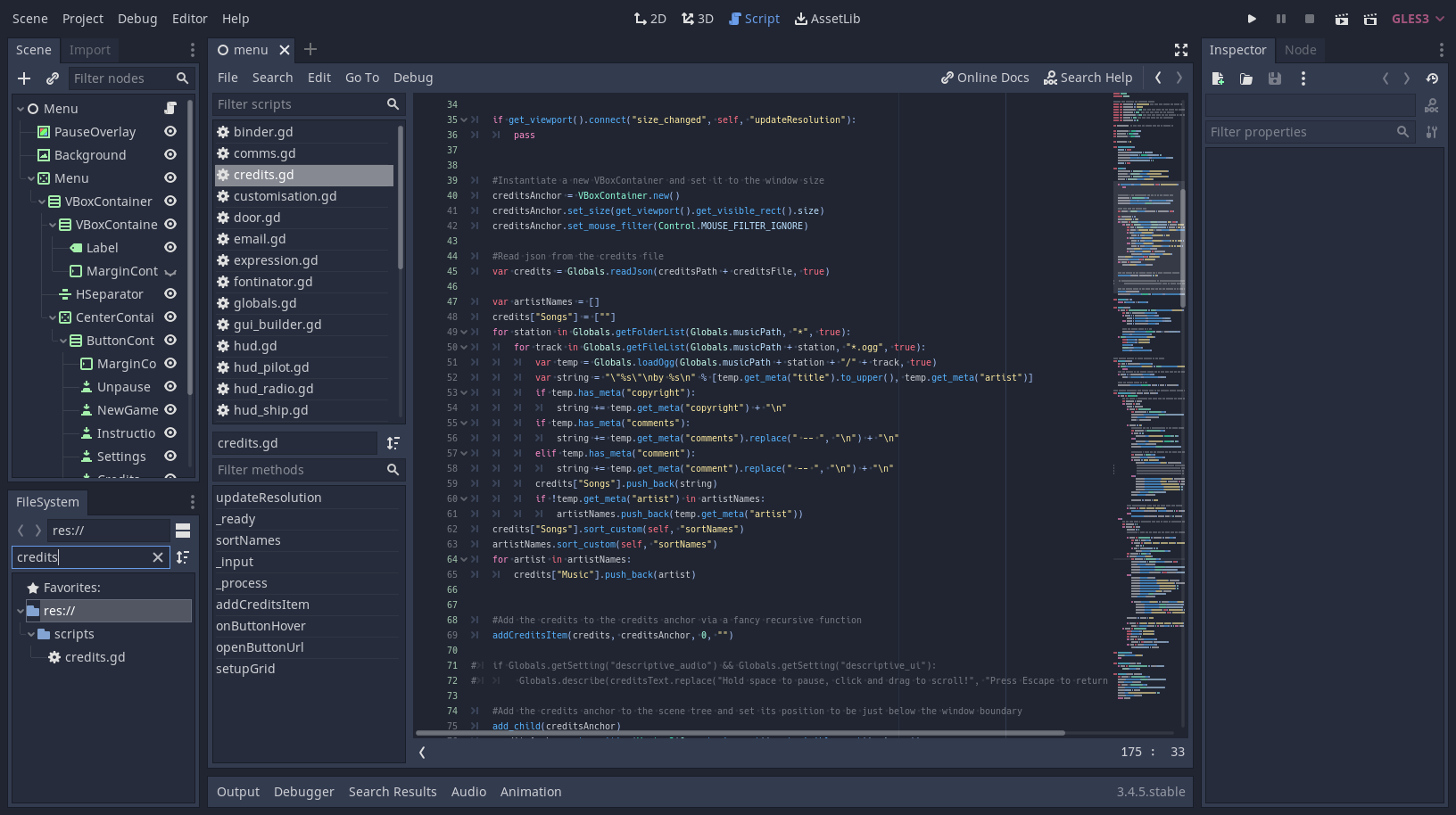
It's a minor thing, but I'm also very happy with how the automated song credits came out. It was great to be able to feature/showcase all the tracks like that, and to do so in a way that didn't add an administrative overhead that would leave me as a point of failure if I'd forgotten to manually update the credits or something.
I'm pretty happy with how the player ship environment came out in the end, especially after getting the head in there. It's not quite as stylistically cohesive as I think I would have liked to have made it - I'd intentionally wanted to keep things bland so that the flashing lights, buttons, dials, and other bits and pieces could have prominence, but since I didn't really get any of that stuff in, it does feel a little bland and doesn't carry forward that style I'd set with the radio's model. Still, I think that as minimal as what's there is, it's a space that for me, conveys the right balance of feeling claustrophobic but cozy, utilitarian but adapted to be humanist, and dingy but not gross.
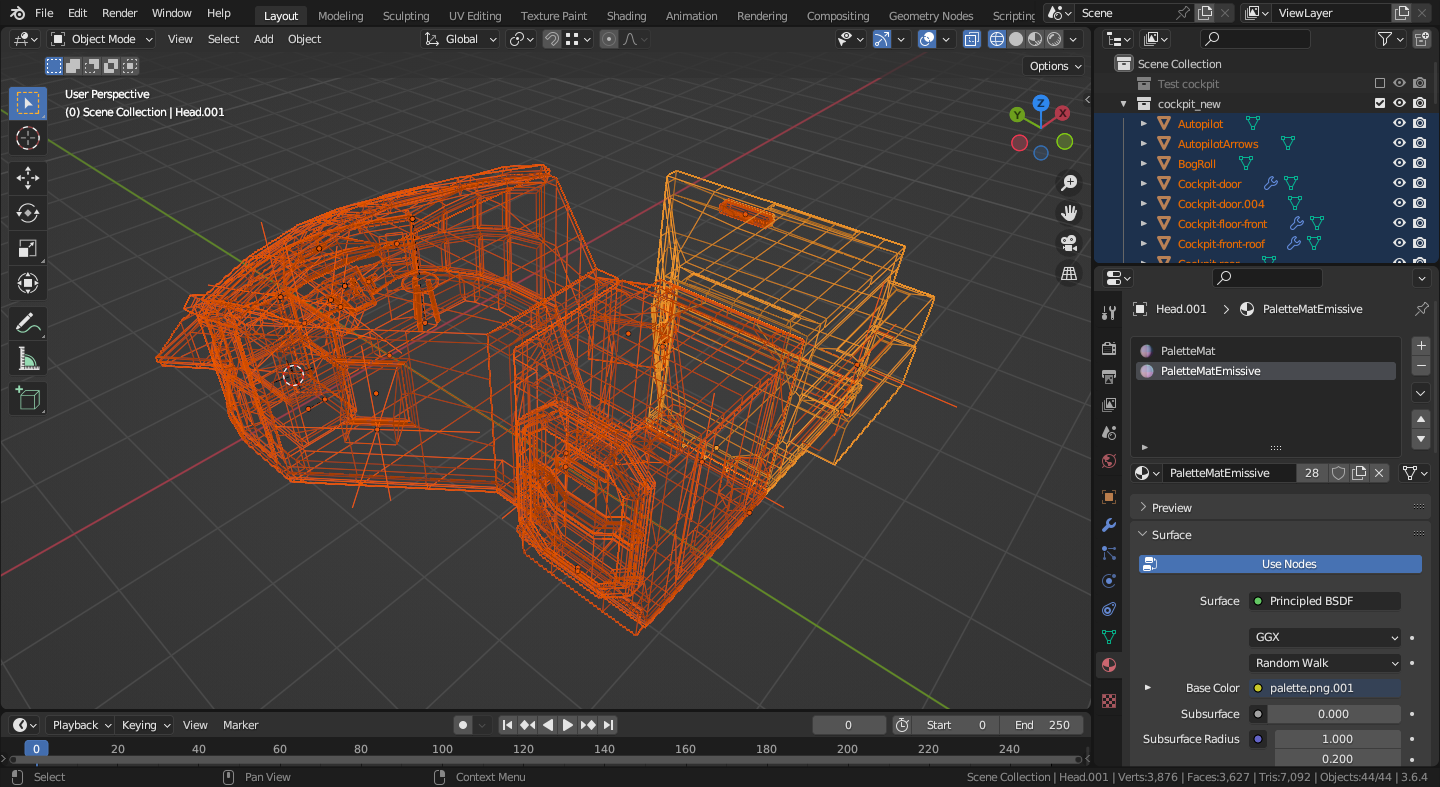
Similarly, I really like the station and ship models that I was able to put together. The ships in particular didn't quite go in the direction I had in mind, but I enjoyed making them and love how they turned out.
Up until I got the sink mirror into the game (and adding it was worth the tradeoff), I felt very good about how I'd managed to hide stuff like the lack of walk and sit animations. I often try, especially when working with tight time constraints, to do as much as possible with as little as possible, and often that means leaving stuff out in a way that doesn't make it obvious that it's left out. In particular, I enjoy how the console mirror shows the player's head and shoulders, but with the chair back blocking the view, it's never possible to really get a good look at the player's body and legs. It's also very difficult to notice that when looking left and right while sitting, the entire body just rotates rather than the head turning.
In general, I like the interactivity of the map screen. Planning out routes and trying to think ahead in order to meet up with another pilot feels fun.
What didn't go so right
One of the things I was most disappointed by was being unable to properly alleviate/minimise the impact of loading freezes when previously unseen materials come into view. My usual approach for working around this is to hide geometry using all materials somewhere within the camera frustum, and in Hive Time, Bat Egg, and Fossil Sweeper, this works fairly reliably. I catch some of it when starting a new game or loading a game for the first time, but there are still some freezes left. I don't know what's going on and didn't feel like I had time to get to the bottom of it - perhaps the mirrors are complicating things in a way I hadn't anticipated.
The wave gesture's timing makes it appear to have a hitch when blending from the sitting rest state animation. I think I could have reworked the wave to be offset by half so that it wouldn't be coming to a stop just after as the influence of the rest pose ended, but it was difficult to justify spending time on.
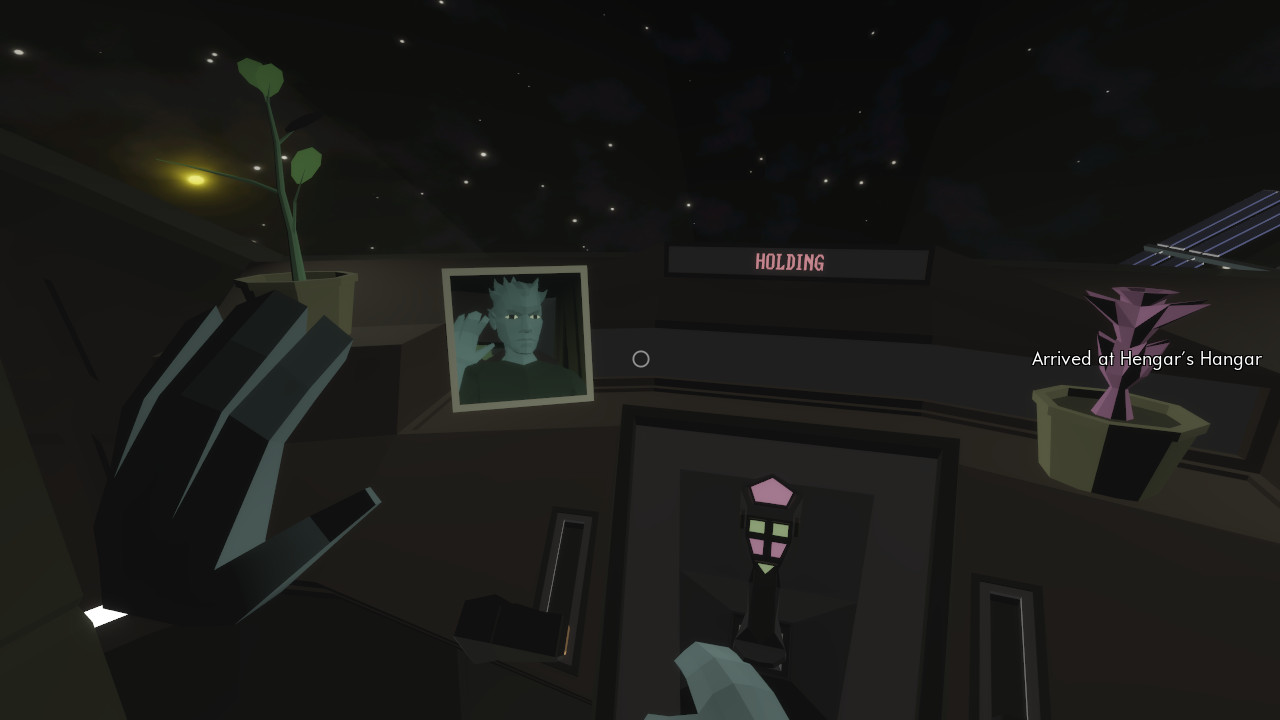
For a long time (up until v0.3-3, the last hotfix at the time of writing), I had a bug where the blink masks could get stuck. It'd come right after clicking again, and seemed to only happen when clicking wildly, so it didn't feel like it affected normal gameplay, but it definitely seems that when presented with a novel mechanic like that, most(?) players will want to experiment and test its limits, so players encountered it a lot more than I was expecting. The bug was to do with delayed state changes overriding current states, leading to the code controlling the eye mask thinking the eye was already open when it wasn't. My solution was a bit brute-force, but I think I could have worked around it more gracefully by refactoring the blink shaders into a single shader and using min()/max() to handle the third "both eyes" mask rather than having GDScript code fuss about states like that.
The movement particles that are meant to suggest stars/space particles whizzing past are super janky. They're emitted from a large particle system some distance away from the cockpit, and occasionally a particle will penetrate through into the player's ship. They'll also pass through NPC ships (though it's not noticeable). The slow down and speed up transitions are handled by scaling the particle effect, which looks pretty rough if you're paying attention. I would have liked to have written a custom shader to give me more control over the presentation of particles, and have it consistently render behind everything. Once again, it was difficult to justify spending time on these when they conveyed what they need to and other stuff that needed attention.

I definitely didn't manage to get character interactions with NPCs to a point where they were able to convey a sense of getting to know somebody. Mechanically, there are numbers that go up, and some feedback to tell you when you've done something right (response animations, messages, prop rewards), but since I didn't get to write any characterisation, there's nothing to empathise with, and since I didn't write any NPC quests, there's nothing to use that empathy to make decisions on. I started this project with the intention of doing the things I wasn't able to realise for Cloud Courier, and it's a bummer to know I didn't get there. I did get closer though, and as a proof of concept, or a base to build from, it still feels worthwhile.
I streamed the majority of my work during the jam (which was good), but as I write this, I find myself wishing I'd kept archives that I could grab clips from to include. I know that I frequently forgot to return from my BRB screen, which led me to consciously not keep stuff I would otherwise have made timelapses of (like modelling space ships).
I think my biggest failing for the jam was in not meeting my target work hours. Whenever I participate in a jam, I try to set myself an upper limit on the hours I spend sitting at my desk, and an "ideal target" below that. My target was 6 hours a day, and with an average of over 9.5 hours across the seven days, I went a long way over. Although I don't feel like I let myself get too carried away or allowed myself to get into unhealthy territory, my longest day was 14.5 hours, and that's a long way from good. I think a lot of that was driven by my desire to get to a point where I could start telling NPC stories/implementing little quests.
I could potentially have gotten there a lot faster if I'd have gotten rid of the non-seated aspects of the game, and in hindsight, maybe that would have been the best thing to do... but that scope change would have also meant removing most of the "FPS" aspects and hurt the sense of the ship being a lived in space. Beyond that, I'm not sure there's anything that could have gone differently that would have changed how I engaged with the jam, so the main takeaway I have is that I need to be more mindful and be OK with not achieving everything I want.
There were a few things that I got bogged down in such as my silly mistake with collisions, spending a bunch of time on AnimationTree and then wrestling with settings to make sure my animations were exported/imported correctly, getting stations spinning correctly, and some rotation hurdles with anchoring props to the player's hands, but all up, the "wasted" time there wouldn't add up to more than 4 or 5 hours across the week, which would still have my daily average up around 9 hours.
What got left out
To give some an idea of how I prioritised work items and navigated the project, here's a look at the things that I didn't get to. The things that were lower priority or harder to fit into development constraints might help give some context the kinds of things I was thinking about while working on the game. Keep in mind that these notes are in a kind of short hand - the minimal needed for Past Me to tell Future Me what I was thinking of. They would all be refined and iterated on while implementing, and some may be mutually exclusive.
Narrative/worldbuilding
- NPC characterisation
- Anxious person who appreciates it when you find ways to calm/sooth them
- Plant enthusiast
- Musician
- Spaceship gearhead?
- Eyepatch guy who doesn't like it when you wink with that eye?
- Angry gowron guy (wide eyed stare - rams you if he thinks you're mocking him?)
- Flirty person who gets bored if you're not showing them new stuff all the time
- Person who loves it when you pull dumb faces at them (they try to ignore you and then respond with a dumb face - once you engage them, they do more and more outrageous faces/poses)
- NPC relationship archetypes
- Friend
- Confidant
- Enemy
- Lover
- Collaborator
- Protector
- Suporter
- NPC quests
- Find out about a secret smuggling run, use secret gesture combination to warn them about authorities so they can avoid capture
- Use a secret gesture combination to communicate hidden message to underground spies
- Take someone's run to cover for them (have to give all their expressions/gestures to avoid detection)
- Rescue someone who has run out of fuel?
- Get rescued after crash landing somewhere?
- Romance?
- Get an important job from them
- Encourage them to submit a song to a radio station
- Race from one location to another (scripted to lose and the winner shows you a secret route connecting two distant locations?)
- Adopt/rescue a pet
- Identify an imposter (they don't give their normal expressions/gestures?)
- NPC-NPC relationships (pilots can comment on your interactions with/share things about other pilots)
- NPCs with high disposition can tell you one of their likes or dislikes, tying into some personal detail or secret
Mechanics
- Head movement as gestures
- Nodding
- Shake head
- Chin up
- Look away
- Gestures as choices in branching "dialogue"
- Scissors-paper-rock minigame to play with NPC pilots with high disposition
- Open mouth shape keys (had created head mesh with accidentally merged )
- Learn new gestures from pilots
- Tiredness (need to sleep periodically or eyes droop automatically, interactions impact tiredness - positive/negative?)
- Disposal chute/retrieval arm (drop/pick up props for/from NPCs?)
Cosmetic/fluff
- Interact with prop instead of picking up (tap to interact, hold to pick up/put down - water plants, eat food, trigger sound, etc.)
- Pick up mirror/radio
- Customiseable clothing
- More props
- Puzzle (not-Rubik's Cube?)
- Sextant
- More stuffed toys
- More plants
- Easter egg props (Hive Time, Bat Egg, Fossil Sweeper, FLAT, etc.)
- More blinking lights/interactive console stuff
- More head/toilet interactivity
- Walk animation
- Right hand transform refs for all props
- Chair animations
- More gestures
- Finger guns
- Fist bump
- Heart hands
- Cover eyes
- Pull bottom eyelid?
- More face expression animations
- Tongue
- Kissy
- Surprise
- Mouth open smile
- Mouth open frown
- Radio stations specific to regions (with overlap)
- Hammock
- Cockpit decorations (placeable posters, stickers - peel over time and need to be put back up periodically?)
- Interactive console buttons/switches
UI/UX
- Autosave icon
- Scale cursor with window size
- Scale gesture selection icons with window size
- Set mouse/brow facial expression via radial menu (bound to 2?)
- Blind-friendly play (more TTS/audio cues)
- Binding to back a step in customisation flow?
- Rename comms station to nav station?
- Separate messages out to its own interactive device?
- Change "X liked that" to be more descriptive about disposition tiers/relationship state
Audio
- More ship engine sounds/ducking when doors are closed
- New message sound
- Footstep sound
- Sit sound
- Ambient console beeps/sounds
- Interact sound
- Pick up sound (prop-specific?)
- Put down sound (prop-specific?)
- Pilot reaction sounds (gibberish voice?)
- Daydream audio effect (bus effect + ambient music?)
- Typing sound (already recorded)
Bigger game stuff
- Station services (different service available at each location, all abbreviate to SD)
- Safety deposit
- Safe disposal
- Secure dispatch
- Ship detector
- Speedy destination
- Multiple map sectors
- Secret routes
- Pet
- Cat
- Parrot
- Dog
- Fish
- Stop mid-route to have longer conversations/investigate stuff between stations
- Mid-route points of interest? (derelict ships, comets, interesting asteroids, rogue planets, unusual signals?)
- EVA?
- Receive messages from the universe while daydreaming
- THE SIGNAL
- Become a fugitive (pick up a police scanner addon for the comms station?)
- After a disaster, recruit and rally your friends (maybe sector-wide systems loss destroys all emails, records, etc., and you reconnect using stuff you've already learned?)
Phew. After all that stuff that didn't make it into the game, how about some extra detail on something that did - like music! More on that in Part 3!
Get Wink Commander (7DFPS 2024)
Wink Commander (7DFPS 2024)
A game about winking at spaceships
| Status | Prototype |
| Author | Cheeseness |
| Genre | Simulation |
| Tags | Low-poly, relationship, Space, wink |
| Languages | English |
More posts
- Wink Commander Postmortem Part 3: Space TunesFeb 05, 2025
- Wink Commander Postmortem Part 1: Inspirations & 7DFPSFeb 05, 2025
- v0.3-6 changelogFeb 05, 2025
- v0.3, v0.3-3 changelogsJan 01, 2025
- v0.2-1 changelogDec 17, 2024

Leave a comment
Log in with itch.io to leave a comment.